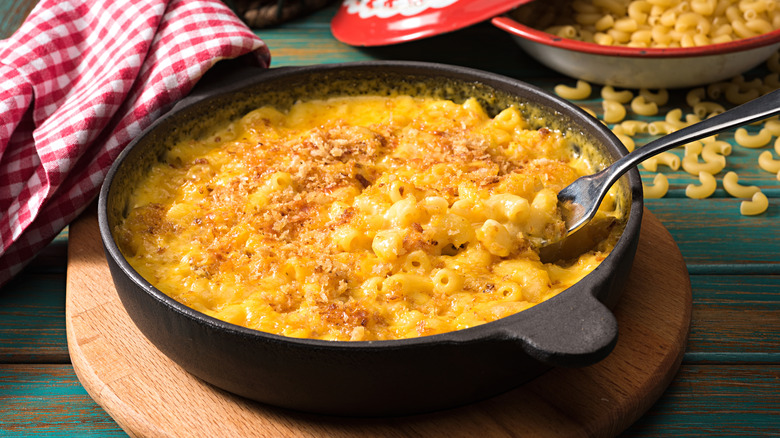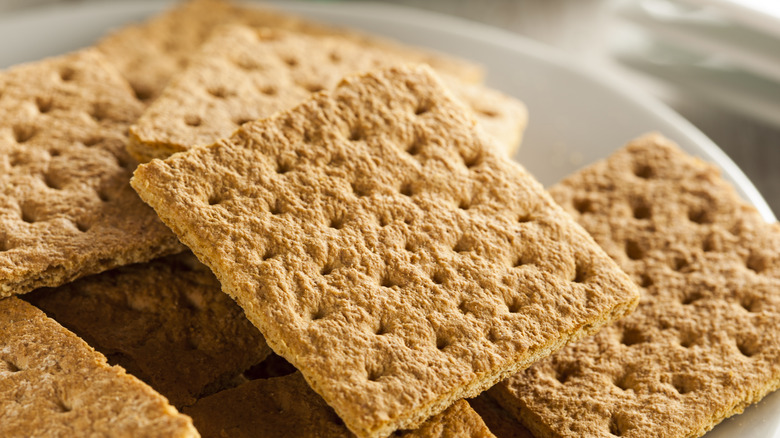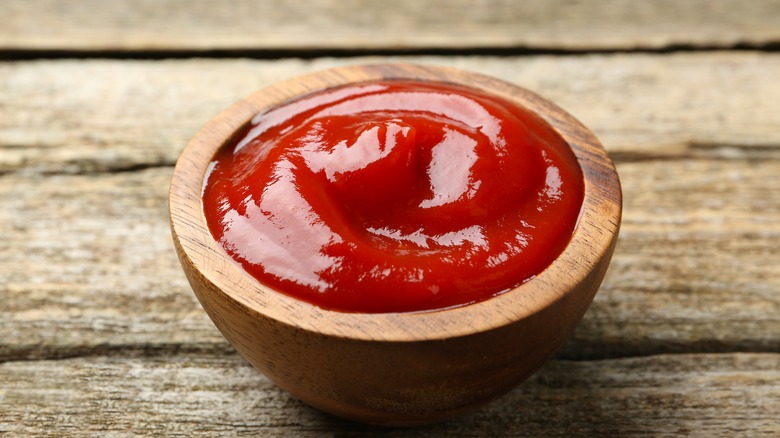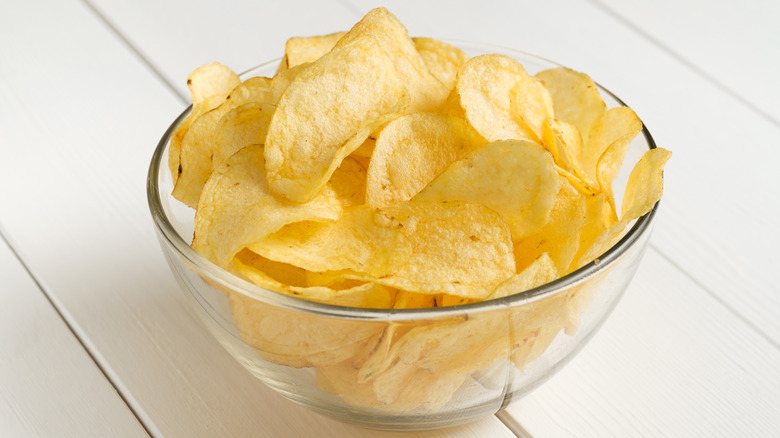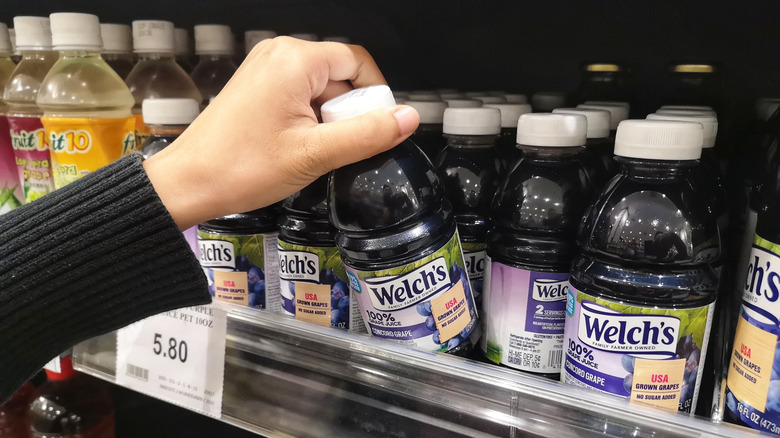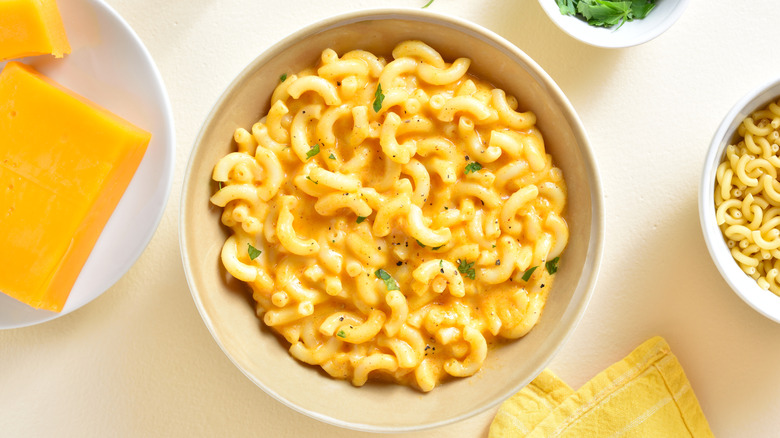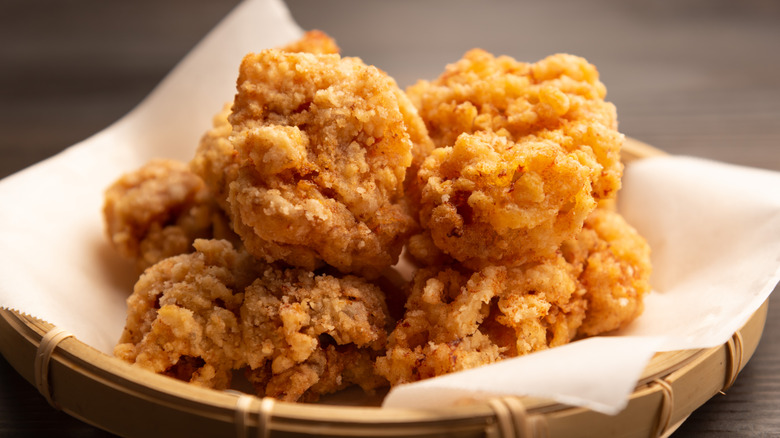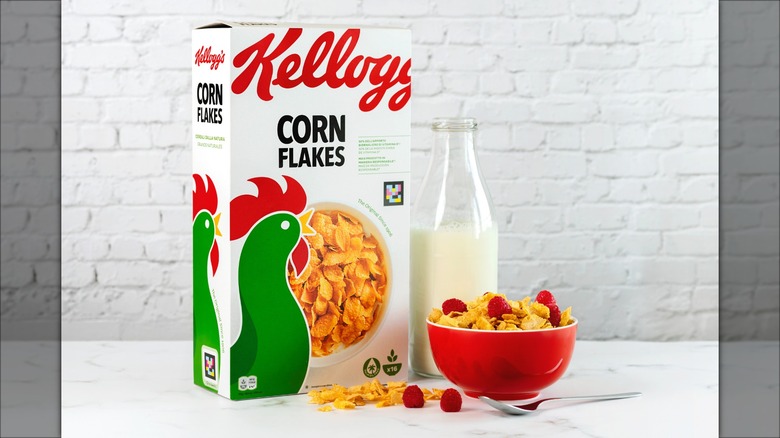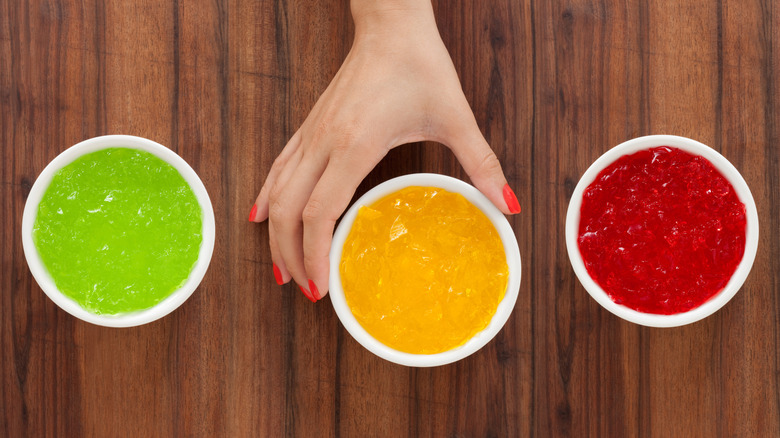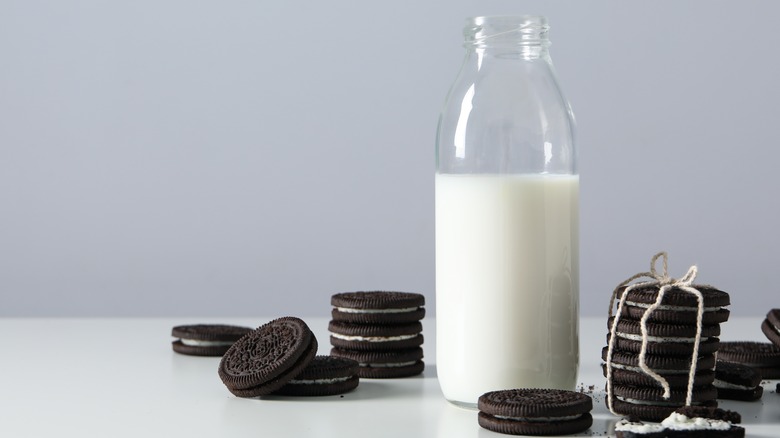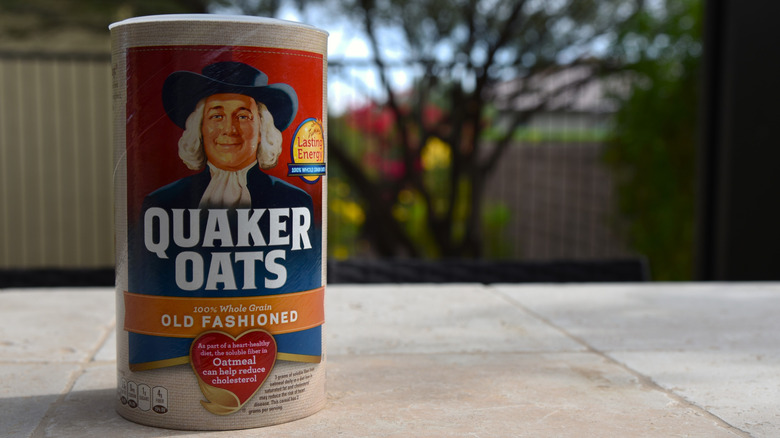Popular Foods That Have Been Around Longer Than You Realized
Food trends come and go with the seasons. Whether it's Jell-O salad or TikTok's viral pancake cereal, many beloved recipes are mere flashes in the pan, wildly popular trends with a short shelf life. Looking back on these recipes now is like transporting yourself to a bygone era. It's impossible to make Jell-O salad or ambrosia salad without evoking the '50s and '70s, and no matter how many fancy ingredients you add to meatloaf, it will still have 20th-century connotations. These dishes are, by nature, old-fashioned, but others have withstood the test of time and seem immune to trends. It's hard to imagine peanut butter and jelly going out of style anytime soon, and the idea of pizza becoming passé now or even far into the future is laughable.
Out of all the classic foods that remain popular, however, some have been around even longer than you might have suspected. Whether they're associated with a certain time in history or are constantly receiving upgrades on fast food menus, their extensive histories will probably surprise you. From the upscale beginnings of the potato chip to the ridiculously wholesome tale of the popsicle, here are the unexpectedly distant origin stories of some of today's most popular foods.
Graham crackers
Graham crackers have been around since the 1820s, and their invention had nothing to do with childhood snacking or s'mores. The favored after-school snack of many an elementary school student was created by Sylvester Graham, a Presbyterian minister from New England who thought all the newfangled food that had been invented since the beginning of the Industrial Revolution was robbing Americans of their purity. He was intent on ushering his fellow citizens toward salvation, and that meant feeding them flavorless, whole grain sheets of crunchy crackers that he named after himself.
Graham had strict ideas about virtue. To him, the anti-alcohol, anti-tobacco advocates of the day were missing the target. Sex was the real disease plaguing the nation. He believed that the increasingly processed, flavorful American diet was leading to unbridled lust, and he was darned if he was going to let the country succumb to its urges. He wrote a treatise on bread that stretched to more than 20,000 words in which he railed against industrially produced white bread. People were careless about the bread they ate, he complained, eating "the most miserable trash that can be imagined." He created Graham crackers to fix the problem, and believed they were the ideal breakfast food because they could quell sexual urges for the entire day. His recipe may not have had the desired effect, but it caught on and became one of the most enduring snack foods in the American diet.
Ketchup
According to food historian Joyce White, ketchup can be traced back to the 17th century, when merchants imported a product known as "high East-India sauce" to Britain from Asia. The coveted condiment was not, however, what we know and love today. "While tomato ketchup certainly reigns supreme as a beloved American condiment," White told Mashed, "[I]n the past ketchup was made from a surprising number of ingredients other than tomatoes, including mushrooms, walnuts, berries, wine, rum, kidney beans, liver, seafood, and numerous fruits and vegetables, including cucumbers."
Colonial Americans were known to import British-style ketchup to North America, but it was the enterprising minds of cooks in the Colonies rather than in England who would pioneer ketchup as we now know it. "The earliest known tomato ketchup recipe is found in the c.1795 Cooperstown, NY manuscript recipe book of a Mrs. Michel," White explained. It wasn't until 1876 that ketchup became widely available to purchase thanks to a little company known as Heinz. According to White, ketchup was one of the many foods shaped by industrialization. "It is much easier to purchase it premade than to spend countless hours peeling, cooking, and puréeing the tomatoes followed by a lengthy period canning the final product for storage," she said, adding that, by the time America's hunger for burgers and fries rolled around in the mid-20th century, its fate was sealed.
Potato chips
It's difficult to imagine a sandwich shop that doesn't stock potato chips, but it's equally difficult to imagine English dandies chomping down on a handful of the crunchy snack in the early 1800s. But the latter may well have happened. William Kitchiner, an English doctor, was the first person to publish a recipe for potato chips in 1817, but the creation didn't take off until a similar recipe was developed at a resort in Saratoga Springs, New York around 1853. The legend goes that George Crum, a chef of Native and African American descent, fried up a bowl of potato chips to spite the railroad tycoon Cornelius Vanderbilt, who had sent his potatoes back to the kitchen complaining they were sliced too thickly.
Another version of the story argues that the Saratoga Springs recipe was created by another cook at the resort named Eliza but was popularized by Crum. Regardless of the real creator, potato chips became the restaurant's claim to fame, and other fine dining establishments rushed to add them to their menu. Eventually, manufacturers began to sell them outside the exclusive arena of upscale restaurants. Even Al Capone is said to have been a fan. When Lay's found a way to manufacture and distribute potato chips on a large scale in the 20th century (keeping the chips crunchy and whole during long-distance transport was no easy feat), the snack became an American staple.
Welch's grape juice
There are many grape juice brands on the market, but one of the most ubiquitous is Welch's. Dating all the way back to the late 19th century, it's an elder statesman among fruit juice brands, but its founder wasn't particularly interested in marketing the product to juice drinkers. In 1869, a New Jersey dentist named Thomas Bramwell Welch bottled his first batch of grape juice and marketed it as Dr. Welch's Unfermented Wine. Noticing that the only communion options were alcoholic, he thought he was filling a much-needed gap in the market. In order to prevent the juice from fermenting and defeating his whole concept, Welch sealed it in bottles and boiled them, a form of pasteurization that was groundbreaking at the time.
Unfortunately, there seemed to be little appetite for unfermented wine among churchgoers or anyone else. It wasn't until Welch's son suggested the product be rebranded as Dr. Welch's Grape Juice that the enterprise took off. After exhibiting the sweet purple drink at the 1893 World's Fair in Chicago, it became a popular beverage.
Macaroni and cheese
Many of the foods we love today are rooted in the Black culinary tradition. Mashed spoke with food historian Deb Freeman, whose docuseries, Finding Edna Lewis, explores the life and legacy of a chef who helped reshape the perception of Southern food in America. "Black culinary history has shaped our modern food landscape because nearly every Southern dish passed through enslaved hands," Freeman said. "Because of their intelligence and ingenuity, they unwittingly created a true American cuisine by perfecting dishes like barbecue, sweet potato pie, and countless others, all while living with the fear of punishment, being sold, or any number of inhumane treatments." One such dish that was shaped by enslaved people was macaroni and cheese. Although it is now considered a casual and indulgent dish, it was once viewed as the epitome of fine dining.
"The American version that is one of this country's favorite comfort foods is here thanks to Thomas Jefferson's enslaved chef de cuisine, James Hemings," Freeman told us. "Hemings traveled to France with Jefferson in 1787, where he learned the most refined and difficult techniques of French cooking. He brought back the template for fine dining in America, and recipes for crème brûlée, meringues, whipped cream, ice cream, and yes, macaroni and cheese."
Popsicles
It's hard to believe that popsicles had to be invented –- they're just frozen juice on a stick after all –- but it took the ingenuity of a California pre-teen to put two and two together. There have been frozen desserts for thousands of years. In ancient Rome, enslaved people were sent to the mountains to collect ice that would be crushed and mixed with flavored syrups, while Marco Polo is said to have sampled an early version of sorbet when he visited the palace of Kublai Khan in the 13th century. Nearly 700 years later, in 1905, an 11-year-old Bay Area native named Frank Epperson accidentally left a cup of water mixed with soda powder outside in the winter with a wooden stirrer in it. The next morning, young Epperson discovered that his drink was frozen solid and that the result was even more delicious and convenient to consume than the liquid had been.
Recognizing that he had something special on his hands, Epperson began selling his frozen treats around the neighborhood, calling them "Epsicles." His innovation proved even more popular when he started selling them at the local beach during the summer. In 1924, Epperson patented his creation, even detailing the type of wood that made the best material for the stick (wood-bass, birch, or poplar). The word "popsicle" was his kids' idea — "Pop's sicle." These days, the frozen treat is so beloved that the word is, like Kleenex, used generically despite being trademarked.
Fried chicken
Fried chicken is a classic and remains a beloved comfort food. It might be viewed as a Southern staple, but Deb Freeman explained to Mashed that early mentions of the dish can be traced back to Scotland. Even the Romans were known to fry strips of meat, though baking and boiling were more common methods of cooking. A recipe for "marinating" chicken can be found in the 1747 British cookbook "The Art of Cookery Made Plain and Easy" by Hannah Glasse, which calls for coating chicken in a batter made with flour and eggs and frying it in hog's lard. However, while this certainly resembled what we now recognize as fried chicken, it wasn't until the mouthwatering dish made its way to the U.S. that it truly took off.
"By the 1700s," Freeman said, "[F]ried chicken was a beloved dish of Virginia governor William Byrd, who wrote about it in his diary, which is the earliest written account in the United States. After the Civil War, many African-American women became entrepreneurs by selling fried chicken. For example, the 'waiter-carriers' of Gordonsville, Virginia met incoming trains to the town with fried chicken and baked goods for sale that were carried in baskets on their heads."
Kellogg's cornflakes
Breakfast cereal is an American institution. Wander into the cereal aisle at any local supermarket and you'll find row upon row of colorful logos and goofy mascots vying for your attention. But the history of at least one beloved cereal is far from this frenzy of technicolor marketing. In fact, Kellogg's corn flakes were born out of the religious and supposedly scientific conviction that food must be bland and made with whole grains in order to be healthy.
Way back in the 1890s, Dr. John Harvey Kellogg was the medical director of an upscale health and wellness center founded by the Seventh-Day Adventist Church. He had many questionable views on public health beyond his belief that bland food led to good health. He was a proponent of sexual abstinence and later became a leader in the eugenics movement, the racist, pseudo-scientific idea that the genetic makeup of the human race could and should be improved through selective breeding. He and his brother, Will Keith Kellogg, invented corn flakes in 1898 to provide a healthy, easily digested breakfast for their patients. The original recipe had no sugar or flavorings and the results were not nearly as crunchy as they are today. Despite the initially unappetizing recipe, however, the brothers tinkered with their formula, and in 1906, opened the Battle Creek Toasted Corn Flake Company, which went on to become Kellogg's.
Jell-O
When you think of Jell-O, you might imagine elaborate wobbling salads of the 1960s. But the history of Jell-O dates back much further. Foods made with gelatin have been popular since the Middle Ages, but until the Industrial Revolution, it was far too laborious for home cooks to make from scratch, leaving it largely to the wealthiest diners to enjoy. By the 18th century, it had made its way to North America, where Thomas Jefferson was known to enjoy a dessert made of gelatin and Madeira wine and flavored with lemon, cloves, and nutmeg.
It was an industrialist in New York who finally found a method for making the ingredient accessible to busy homemakers. Peter Cooper patented a product that he called Portable Gelatin, a flavorless and colorless powder that turned into jelly with the addition of hot water. He didn't attempt to market it, however, and the patent was sold to cough syrup manufacturer Pearl Wait in the 1890s. It was during this period that instant gelatin became recognizable by modern standards. Wait and his wife May experimented with adding fruit juice and sugar to the powder, and renamed it Jell-O. After less than a decade, however, the Wait's sold the brand for $450 due to financial struggles. With a savvy marketing campaign featuring cookbooks and door-to-door salesmen, Jell-O finally took off in the first decade of the 20th century to become one of the country's most recognizable food brands.
Oreos
Oreos are unmistakable. With their creamy, sugary filling and intricately patterned chocolate layers, they are a mainstay in American snacking that never go out of style. Their history is even more lengthy than you might imagine. Decades before Post and Kellogg's duked it out in the so-called "cereal war," Oreos were forged in the fires of the "biscuit war."
American cookie production in the late-19th century was dominated by three companies -– the New York Biscuit Company, the American Biscuit Company, and the United States Baking Company. After an intense rivalry, the American Biscuit Company was sold to the New York Biscuit Company in 1897 to form Nabisco. Far from cooling the battle, the truce led to another. Jacob Loose, who had founded the American Biscuit Company and was furious that his creation had been sold out from under him, created the Loose-Wiles Biscuit Company in 1902 and made it Nabisco's toughest competitor. Its signature and most successful cookie was the Hydrox.
Despite sounding like a cleaning product, it was a mouthwatering and beautiful creation, featuring two dark chocolate biscuits with exquisitely rendered patterns sandwiching a vanilla filling. If Nabisco hadn't been shamelessly competitive, we might all be eating Hydroxes today, but instead, Nabisco released their own version of the cookie, calling it the Oreo. It wasn't as intricate as the Hydrox and its filling didn't have vanilla flavoring, but thanks to Loose-Wiles' bungled marketing response, the Oreo eventually became the definitive cookie sandwich.
Quaker Oats
Given its vintage-looking logo of a bewigged man in Quaker garb, you might assume that Quaker Oats was an old company, but it would be difficult to predict exactly how old. After all, Cap'n Crunch sports the uniform of an 18th-century naval captain, but that doesn't mean the cereal was introduced in the 1700s (it was the 1960s, in fact). Quaker Oats may not be as old as its logo suggests, but for a brand that remains ubiquitous in grocery stores and households around the country, its roots are decidedly retro.
It was trademarked in 1877 by Henry Parsons Crowell, the owner of an Ohio mill called Quaker Oats which became one of many successful oat mills in the country since the 1850s. It was the first cereal to be trademarked, marking the beginning of one of the most beloved and commercialized categories of breakfast food in the country. The patent was for the character of a man dressed in Quaker garb. Future owners would later explain that the image was chosen so that shoppers would associate the brand with the Quaker values of integrity, value, and quality. Despite the patent, Cromwell's mill was not prosperous, and it was soon sold. In 1888, seven of the largest oat millers in the country formed a single company, and in 1901, it adopted the logo and name of one of its small acquisitions: Quaker Oats.
PEZ
There is something timeless about PEZ. For children, the product is equal parts candy and toy. For some adults, it is also a nostalgic and valuable collector's item. These days, you can purchase dispensers modeled after movie and TV characters, such as the Little Mermaid, Mufasa, and SpongeBob Squarepants. It's safe to say that none of these characters –- even ones as old as Donald Duck – were on the mind of the creator of the brand when he dreamed up his idea.
PEZ was invented in 1927 in Austria by baking powder manufacturer Eduard Haas III. The name was derived from the German word for peppermint, pfefferminz, taking the first, middle, and last letters. At the time, the candies were made with peppermint oil and sold in tins. Instead of marketing them to children, Haas had something else in mind: ending smoking. As a staunch anti-smoking advocate, he wanted to provide adult consumers with a breath mint that would distract them from the urge to light up. An early ad quipped, "Smoking forbidden, PEZ-ing allowed." Despite the popularity of the product, it wasn't until 1949 that inventor Oscar Uxa secured a patent for the now-famous dispenser. Uxa had already filed a patent for a cigarette lighter in 1934, and his design for PEZ was remarkably similar. Within a decade, PEZ was available in America and had pivoted to marketing to children by adding the heads of characters to the dispenser and introducing fruit flavors.
